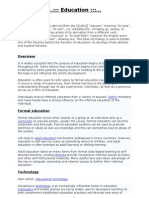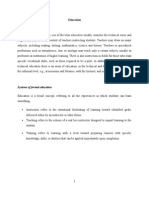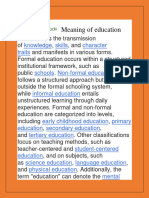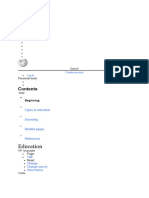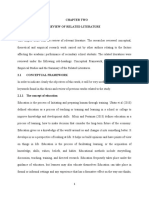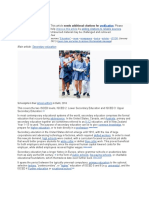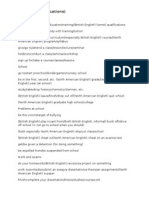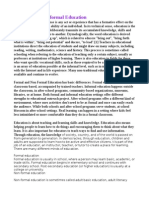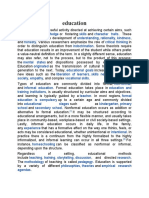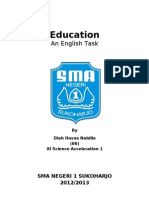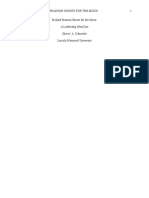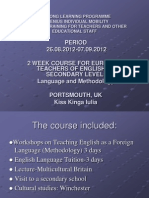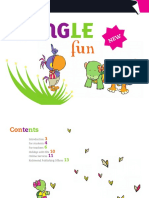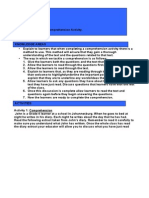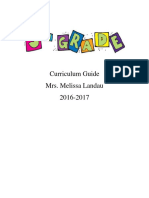Education
From Wikipedia, the free encyclopedia Jump to: navigation, search "Educate" redirects here. For the journal published by the Institute of Education, see Educate~. For the stained-glass window at Yale University, see Education (Chittenden Memorial Window). Education in the largest sense is any act or experience that has a formative effect on the mind, character or physical ability of an individual. In its technical sense, education is the process by which society deliberately transmits its accumulated knowledge, skills and values from one generation to another. Etymologically, the word education is derived from educare (Latin) "bring up", which is related to educere "bring out", "bring forth what is within", "bring out potential" and ducere, "to lead".[1] Teachers in educational institutions direct the education of students and might draw on many subjects, including reading, writing, mathematics, science and history. This process is sometimes called schooling when referring to the education of teaching only a certain subject, usually as professors at institutions of higher learning. There is also education in fields for those who want specific vocational skills, such as those required to be a pilot. In addition there is an array of education possible at the informal level, such as in museums and libraries, with the Internet and in life experience. Many non-traditional education options are now available and continue to evolve. A right to education has been created and recognized by some jurisdictions: since 1952, Article 2 of the first Protocol to the European Convention on Human Rights obliges all signatory parties to guarantee the right to education. At world level, the United Nations' International Covenant on Economic, Social and Cultural Rights of 1966 guarantees this right under its Article 13.
Systems of formal education
Education is the process by which people learn: Instruction refers to the facilitating of learning, usually by a teacher. Teaching refers to the actions of a real live instructor to impart learning to the student. Learning refers to learning with a view toward preparing learners with specific knowledge, skills, or abilities that can be applied immediately upon completion.
Preschool education
Main article: Preschool education
Primary education
Main article: Primary education Primary school in open air. Teacher (priest) with class from the outskirts of Bucharest, around 1842. Primary (or elementary) education consists of the first 57 years of formal, structured education. In general, primary education consists of six or eight years of schooling starting at the age of five or six, although this varies between, and sometimes within, countries.
�Globally, around 89% of primary-age children are enrolled in primary education, and this proportion is rising.[2] Under the Education for All programs driven by UNESCO, most countries have committed to achieving universal enrollment in primary education by 2015, and in many countries, it is compulsory for children to receive primary education. The division between primary and secondary education is somewhat arbitrary, but it generally occurs at about eleven or twelve years of age. Some education systems have separate middle schools, with the transition to the final stage of secondary education taking place at around the age of fourteen. Schools that provide primary education, are mostly referred to as primary schools. Primary schools in these countries are often subdivided into infant schools and junior school.
Secondary education
Main article: Secondary education In most contemporary educational systems of the world, secondary education comprises the formal education that occurs during adolescence. It is characterized by transition from the typically compulsory, comprehensive primary education for minors, to the optional, selective tertiary, "post-secondary", or "higher" education (e.g., university, vocational school for adults. Depending on the system, schools for this period, or a part of it, may be called secondary or high schools, gymnasiums, lyceums, middle schools, colleges, or vocational schools. The exact meaning of any of these terms varies from one system to another. The exact boundary between primary and secondary education also varies from country to country and even within them, but is generally around the seventh to the tenth year of schooling. Secondary education occurs mainly during the teenage years. In the United States, Canada and Australia primary and secondary education together are sometimes referred to as K-12 education, and in New Zealand Year 1-13 is used. The purpose of secondary education can be to give common knowledge, to prepare for higher education or to train directly in a profession. The emergence of secondary education in the United States did not happen until 1910, caused by the rise in big businesses and technological advances in factories (for instance, the emergence of electrification), that required skilled workers. In order to meet this new job demand, high schools were created and the curriculum focused on practical job skills that would better prepare students for white collar or skilled blue collar work. This proved to be beneficial for both the employer and the employee, because this improvement in human capital caused employees to become more efficient, which lowered costs for the employer, and skilled employees received a higher wage than employees with just primary educational attainment. In Europe, the grammar school or academy existed from as early as the 16th century; public schools or fee-paying schools, or charitable educational foundations have an even longer history.
Higher education
Main article: Higher education The University of Cambridge is an institute of higher learning. Higher education, also called tertiary, third stage, or post secondary education, is the noncompulsory educational level that follows the completion of a school providing a secondary education, such as a high school, secondary school. Tertiary education is normally taken to include undergraduate and postgraduate education, as well as vocational education and training. Colleges and universities are the main institutions that provide tertiary education.
�Collectively, these are sometimes known as tertiary institutions. Tertiary education generally results in the receipt of certificates, diplomas, or academic degrees. Higher education includes teaching, research and social services activities of universities, and within the realm of teaching, it includes both the undergraduate level (sometimes referred to as tertiary education) and the graduate (or postgraduate) level (sometimes referred to as graduate school). Higher education generally involves work towards a degree-level or foundation degree qualification. In most developed countries a high proportion of the population (up to 50%) now enter higher education at some time in their lives. Higher education is therefore very important to national economies, both as a significant industry in its own right, and as a source of trained and educated personnel for the rest of the economy.
Adult education
Main article: Adult education Adult education has become common in many countries. It takes on many forms, ranging from formal class-based learning to self-directed learning and e-learning. A number of career specific courses such as veterinary assisting, medical billing and coding, real estate license, bookkeeping and many more are now available to students through the Internet.
Alternative education
Main article: Alternative education Alternative education, also known as non-traditional education or educational alternative, is a broad term that may be used to refer to all forms of education outside of traditional education (for all age groups and levels of education). This may include not only forms of education designed for students with special needs (ranging from teenage pregnancy to intellectual disability), but also forms of education designed for a general audience and employing alternative educational philosophies and methods. Alternatives of the latter type are often the result of education reform and are rooted in various philosophies that are commonly fundamentally different from those of traditional compulsory education. While some have strong political, scholarly, or philosophical orientations, others are more informal associations of teachers and students dissatisfied with certain aspects of traditional education. These alternatives, which include charter schools, alternative schools, independent schools, and home-based learning vary widely, but often emphasize the value of small class size, close relationships between students and teachers, and a sense of community.
Indigenous education
Main article: Indigenous education Increasingly, the inclusion of indigenous models of education (methods and content) as an alternative within the scope of formal and non-formal education systems, has come to represent a significant factor contributing to the success of those members of indigenous communities who choose to access these systems, both as students/learners and as teachers/instructors.
Process
Curriculum
Main articles: Curriculum and List of academic disciplines An academic discipline is a branch of knowledge which is formally taught, either at the university, or via some other such method. Each discipline usually has several sub-disciplines
�or branches, and distinguishing lines are often both arbitrary and ambiguous. Examples of broad areas of academic disciplines include the natural sciences, mathematics, computer science, social sciences, humanities and applied sciences.[3]
Teaching
Teachers need to understand a subject enough to convey its essence to students. While traditionally this has involved lecturing on the part of the teacher, new instructional strategies put the teacher more into the role of course designer, discussion facilitator, and coach and the student more into the role of active learner, discovering the subject of the course. In any case, the goal is to establish a sound knowledge base and skill set on which students will be able to build as they are exposed to different life experiences. Good teachers can translate information, good judgment, experience and wisdom into relevant knowledge that a student can understand, retain and pass to others. Studies from the US suggest that the quality of teachers is the single most important factor affecting student performance, and that countries which score highly on international tests have multiple policies in place to ensure that the teachers they employ are as effective as possible.[14] With the passing of NCLB in the United States (No Child Left Behind), teachers must be highly qualified.
Technology
Main article: Educational technology Technology is an increasingly influential factor in education. Computers and mobile phones are used in developed countries both to complement established education practices and develop new ways of learning such as online education (a type of distance education). This gives students the opportunity to choose what they are interested in learning. The proliferation of computers also means the increase of programming and blogging. Technology offers powerful learning tools that demand new skills and understandings of students, including Multimedia, and provides new ways to engage students, such as Virtual learning environments. One such tool are virtual manipulatives, which are an "interactive, Web-based visual representation of a dynamic object that presents opportunities for constructing mathematical knowledge" (Moyer, Bolyard, & Spikell, 2002). In short, virtual manipulatives are dynamic visual/pictorial replicas of physical mathematical manipulatives, which have long been used to demonstrate and teach various mathematical concepts. Virtual manipulatives can be easily accessed on the Internet as stand-alone applets, allowing for easy access and use in a variety of educational settings. Emerging research into the effectiveness of virtual manipulatives as a teaching tool have yielded promising results, suggesting comparable, and in many cases superior overall concept-teaching effectiveness compared to standard teaching methods.[citation needed] Technology is being used more not only in administrative duties in education but also in the instruction of students. The use of technologies such as PowerPoint and interactive whiteboard is capturing the attention of students in the classroom. Technology is also being used in the assessment of students. One example is the Audience Response System (ARS), which allows immediate feedback tests and classroom discussions.[15] Information and communication technologies (ICTs) are a diverse set of tools and resources used to communicate, create, disseminate, store, and manage information. [16] These technologies include computers, the Internet, broadcasting technologies (radio and television), and telephony. There is increasing interest in how computers and the Internet can improve education at all levels, in both formal and non-formal settings. [17] Older ICT technologies, such as radio and television, have for over forty years been used for open and distance learning, although print remains the cheapest, most accessible and therefore most dominant delivery mechanism in both developed and developing countries.[18] In addition to
�classroom application and growth of e-learning opportunities for knowledge attainment, educators involved in student affairs programming have recognized the increasing importance of computer usage with data generation for and about students. Motivation and retention counselors, along with faculty and administrators, can impact the potential academic success of students by provision of technology based experiences in the University setting.[19] The use of computers and the Internet is in its infancy in developing countries, if these are used at all, due to limited infrastructure and the attendant high costs of access. Usually, various technologies are used in combination rather than as the sole delivery mechanism. For example, the Kothmale Community Radio Internet uses both radio broadcasts and computer and Internet technologies to facilitate the sharing of information and provide educational opportunities in a rural community in Sri Lanka. [20] The Open University of the United Kingdom (UKOU), established in 1969 as the first educational institution in the world wholly dedicated to open and distance learning, still relies heavily on print-based materials supplemented by radio, television and, in recent years, online programming. [21] Similarly, the Indira Gandhi National Open University in India combines the use of print, recorded audio and video, broadcast radio and television, and audio conferencing technologies.[22] The term "computer-assisted learning" (CAL) has been increasingly used to describe the use of technology in teaching.
[edit] Educational theory
Main article: Education theory Education theory is the theory of the purpose, application and interpretation of education and learning. Its history begins with classical Greek educationalists and sophists and includes, since the 18th century, pedagogy and andragogy. In the 20th century, "theory" has become an umbrella term for a variety of scholarly approaches to teaching, assessment and education law, most of which are informed by various academic fields, which can be seen in the below sections.
History
This section needs additional citations for verification.
Please help improve this article by adding reliable references. Unsourced material may be challenged and removed. (November 2010)
Main article: History of education A depiction of the University of Bologna, Italy The history of education according to Dieter Lenzen, president of the Freie Universitt Berlin 1994, "began either millions of years ago or at the end of 1770". Education as a science cannot be separated from the educational traditions that existed before. Adults trained the young of their society in the knowledge and skills they would need to master and eventually pass on. The evolution of culture, and human beings as a species depended on this practice of transmitting knowledge. In pre-literate societies this was achieved orally and through imitation. Story-telling continued from one generation to the next. Oral language developed into written symbols and letters. The depth and breadth of knowledge that could be preserved and passed soon increased exponentially. When cultures began to extend their knowledge beyond the basic skills of communicating, trading, gathering food, religious practices, etc., formal education, and schooling, eventually followed. Schooling in this sense was already in place in Egypt between 3000 and 500BC.The history of education is the history of man as since its the main occupation of man to pass knowledge, skills and attitude from one generation to the other so is education.
�Nowadays some kind of education is compulsory to all people in most countries. Due to population growth and the proliferation of compulsory education, UNESCO has calculated that in the next 30 years more people will receive formal education than in all of human history thus far.[30]






